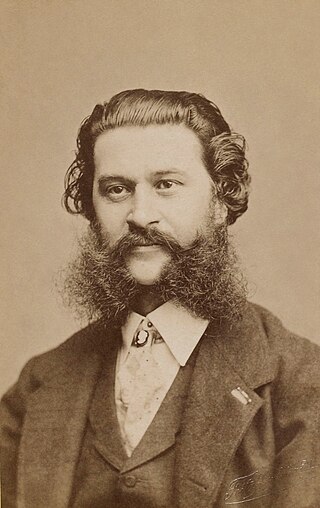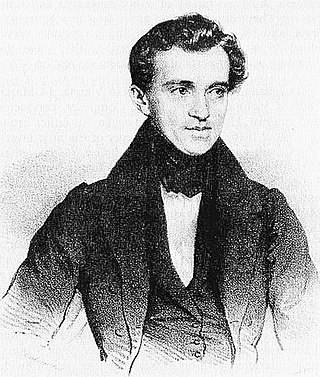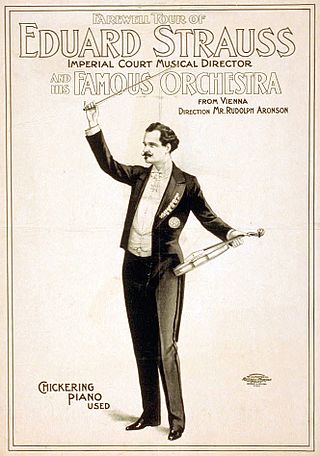Related Research Articles

Johann Baptist Strauss II, also known as Johann Strauss Jr., the Younger or the Son, was an Austrian composer of light music, particularly dance music and operettas as well as a violinist. He composed over 500 waltzes, polkas, quadrilles, and other types of dance music, as well as several operettas and a ballet. In his lifetime, he was known as "The Waltz King", and was largely responsible for the popularity of the waltz in Vienna during the 19th century. Some of Johann Strauss's most famous works include "The Blue Danube", "Kaiser-Walzer", "Tales from the Vienna Woods", "Frühlingsstimmen", and the "Tritsch-Tratsch-Polka". Among his operettas, Die Fledermaus and Der Zigeunerbaron are the best known.

Johann Baptist Strauss I, also known as Johann Strauss Sr., the Elder or the Father, was an Austrian composer of the Romantic Period. He was famous for his light music, namely waltzes, polkas, and galops, which he popularized alongside Joseph Lanner, thereby setting the foundations for his sons—Johann, Josef and Eduard—to carry on his musical dynasty. He is best known for his composition of the Radetzky March.

Eduard "Edi" Strauss was an Austrian composer who, together with his brothers Johann Strauss II and Josef Strauss made up the Strauss musical dynasty. He was the son of Johann Strauss I and Maria Anna Streim. The family dominated the Viennese light music world for decades, creating many waltzes and polkas for many Austrian nobility as well as dance-music enthusiasts around Europe. He was affectionately known in his family as 'Edi'.

Johann Maria Eduard Strauss III was an Austrian composer whose father was Eduard Strauss, whose uncles were Johann Strauss II and Josef Strauss, and whose grandfather was Johann Strauss I. Born in Vienna, he was unofficially entrusted with the task of upholding his family's tradition after the dissolution of the Strauss Orchestra by his father in 1901. His talents were not fully realized during his lifetime as musical tastes had changed in the Silver Age with more popular composers such as Franz Lehár and Oscar Straus dominating the Viennese musical scene with their operettas, although his uncle, Johann Strauss II, supervised his development as a musician, a fact disputed by Eduard Strauss.

Joseph Franz Karl Lanner was an Austrian dance music composer and dance orchestra conductor. He is best remembered as one of the earliest Viennese composers to reform the waltz from a simple peasant dance to something that even the highest society could enjoy, either as an accompaniment to the dance, or for the music's own sake. He was just as famous as his friend and musical rival Johann Strauss I, who was better known outside of Austria in their day because of his concert tours abroad, in particular, to France and England.
Wiener Frauen or 'Viennese Ladies' op. 423 is a waltz composed by Johann Strauss II in 1886.
Liebeslieder op. 114 is a waltz by Johann Strauss II written in 1852. At the time it was conceived, the waltz was titled 'Liebesgedichte' or "Love Poems" and during its first performance, it was even announced as 'Liebesständchen' or "Love Serenade". The first performance was at the famed Vienna Volksgarten on 18 June 1852 under the composer's direction.
Cagliostro-Walzer op.370 is a waltz by Johann Strauss II composed in 1875 based on themes from his operetta, Cagliostro in Wien which premiered on 27 February 1875 at the famous Theater an der Wien.

Kaiser-Walzer, Op. 437 is a waltz composed by Johann Strauss II in 1889. The waltz was originally titled Hand in Hand and was intended as a toast made in August of that year by Emperor of Austria Franz Joseph I on the occasion of his visit to the German Emperor Wilhelm II where it was symbolic as a 'toast of friendship' extended by Austria-Hungary to the German Empire.
Lagunen-Walzer (Lagoon-Waltz) op. 411 is a waltz by Johann Strauss II written in 1883. The waltz melodies are drawn from his operetta Eine Nacht in Venedig which was a fiasco when premiered in Berlin on 3 October 1883.

"Frühlingsstimmen", Op. 410 is an orchestral waltz, with optional solo soprano voice, written in 1882 by Johann Strauss II.
Vergnügungszug, op. 281 is a polka composed by Johann Strauss II in 1864. It was written for the Association of Industrial Societies' Ball held in the Redoutensaal on 19 January 1864 and was inspired by the opening of the Austrian Southern Railway – the Südbahn – which operated many 'pleasure trains' offering trips from Vienna to the countryside.
Adolf AndreySchulz-Evler was a Polish-born composer.

Cagliostro in Wien is an operetta in three acts by Johann Strauss II to a libretto by F. Zell and Richard Genée. It premiered on 27 February 1875 at the Theater an der Wien, featuring Marie Geistinger and Alexander Girardi.
Trau, schau, wem!, Op. 463, is a waltz composed by Johann Strauss II. The composition was dedicated to the portrait painter Franz von Lenbach. It was based on melodies from Strauss's operetta Waldmeister – the work is therefore also known as "Waldmeister Walzer". It premiered on 15 December 1895 in the Golden Hall of the Vienna Musikverein, conducted by Eduard Strauss.

Kettenbrücke-Walzer, Op. 4, is a waltz composed by Johann Strauss in 1828. Its title commemorated the construction of the first chain bridge over the Donaukanal through the inner city, Sophienbrücke in Vienna, built after a design by Ignaz Mitis and completed in 1825.
Rhadamantus-Klänge, Op. 94, is a waltz composed by Johann Strauss II. It was written for the 1851 Vienna Carnival. The title of the work was named after Rhadamanthus, one of the judges of the underworld in Greek mythology. Eduard Strauss, the composer's youngest brother, included the waltz's opening number in his potpourri Bluthenkranz Johann Strauss'scher Walzer, opus 292.

"Gartenlaube Waltz", Op. 461, German: "Gartenlaube-Walzer" is the title of a waltz by the Austrian composer Johann Strauss II. The waltz was dedicated to readers of the magazine Die Gartenlaube, a German weekly for the middle class, which became the most-read magazine in 1890s Germany.
References
- 1 2 "STRAUSS II, J.: Edition - Vol. 14 CD". Naxos . Retrieved 2016-03-18.